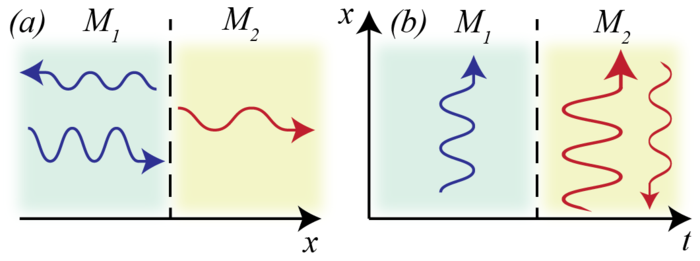At the interface between two media, light is partly reflected backwards into the medium where it came from and partly transmitted into the neighboring medium, like a light ray entering a sparkling pool of water. The light wave patterns that arise from these processes can be usefully tailored using photonic metamaterials, which offer emergent electromagnetic responses that differ fundamentally from those of natural materials.

Credit: Galiffi et al., doi 10.1117/1.AP.4.1.014002.
At the interface between two media, light is partly reflected backwards into the medium where it came from and partly transmitted into the neighboring medium, like a light ray entering a sparkling pool of water. The light wave patterns that arise from these processes can be usefully tailored using photonic metamaterials, which offer emergent electromagnetic responses that differ fundamentally from those of natural materials.
But what happens when we alter the interface between two materials in time? Figuratively speaking, what if the bottom of the pool were suddenly raised, or lowered? Of if, at a certain moment in time, the material properties of a medium were instantaneously changed—say, from water to wine? At the temporal interface between two photonic materials, the momentum of light is conserved, while its energy is exchanged between the electromagnetic waves and the medium. However, the causal relation between the incident and the scattered fields changes fundamentally: both scattered waves in this case propagate within the modified medium.
If combined with the arsenal of scattering phenomena unveiled over the past few decades in wave physics, these basic differences between spatial and temporal scattering can give rise to an extremely broad spectrum of novel concepts and applications in photonics, as well as other waves including acoustic waves.
In a review published in Advanced Photonics, an international team provides a comprehensive overview of the latest advances in this new and fast-developing branch of photonics focused on light–matter interactions in time-varying media. Starting from the basic building blocks of temporal scattering, they review the wide spectrum of opportunities for wave manipulation opened by different forms of time-switching. They look at multiple time-scattering processes, to study periodic and quasiperiodic photonic time-crystals, along with the new directions opened by these constructs for topological physics in the time domain. They discuss the engineering of synthetic frequency dimensions, nonreciprocal gain, and power steering, as well as non-Hermitian time-varying systems, temporal disorder, and surface-wave manipulation achievable through temporal modulation.
The review also explores spatiotemporally modulated media—systems whose electromagnetic parameters undergo a traveling wave-like perturbation—which enable a vast range of opportunities in nonreciprocal to topological photonic designs, the engineering of subluminal and superluminal forms of synthetic motion, optical drag, unidirectional amplification, and other counterintuitive phenomena.
The review concludes by spotlighting some of the most promising platforms to translate these time-varying photonics concepts into experimental realizations and applications in photonics. They also highlight emerging pathways and materials for achieving efficient time modulation, such as epsilon-near-zero materials and high-index dielectric metasurfaces, quantum-well polaritons, magneto-optical modulation, multilayered metamaterials, and 2D materials.
The ripple effects of time-varying photonics are far-reaching and will undoubtedly resonate for many years to come.
Read the open access article by Emanuele Galiffi et al., “Photonics of time-varying media,” Adv. Photonics 4(1) 014002, doi 10.1117/1.AP.4.1.014002.
Journal
Advanced Photonics
DOI
10.1117/1.AP.4.1.014002
Article Title
Photonics of time-varying media
Article Publication Date
14-Feb-2022



